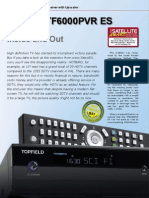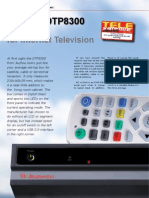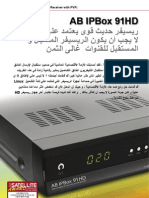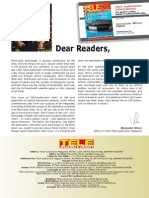Spaun Sotx1310607 NF & Sorx1310607 NF: Straightforward Solution For Optical Fibers in Satellite Signal Distribution
Spaun Sotx1310607 NF & Sorx1310607 NF: Straightforward Solution For Optical Fibers in Satellite Signal Distribution
Uploaded by
Alexander WieseCopyright:
Available Formats
Spaun Sotx1310607 NF & Sorx1310607 NF: Straightforward Solution For Optical Fibers in Satellite Signal Distribution
Spaun Sotx1310607 NF & Sorx1310607 NF: Straightforward Solution For Optical Fibers in Satellite Signal Distribution
Uploaded by
Alexander WieseOriginal Title
Copyright
Available Formats
Share this document
Did you find this document useful?
Is this content inappropriate?
Copyright:
Available Formats
Spaun Sotx1310607 NF & Sorx1310607 NF: Straightforward Solution For Optical Fibers in Satellite Signal Distribution
Spaun Sotx1310607 NF & Sorx1310607 NF: Straightforward Solution For Optical Fibers in Satellite Signal Distribution
Uploaded by
Alexander WieseCopyright:
Available Formats
TEST REPORT Optical Distribution System
SPAUN SOTx1310607 NF &
SORx1310607 NF
Straightforward Solution SPAUN SOTx131
12-01/2011
0607 NF &
for Optical Fibers in
SORx1310607 NF
Connect endles
s satellite and ter
rec eivers to one restrial
single rec eption
Ideally suited for point.
large apartment
blocks.
Satellite Signal Distribution
The attenuation of signal switches
and coaxial cables themselves in
large satellite TV distribution systems
is a factor every installer must take
into account. Less experienced
readers might think that one can
compensate for that by inserting
extra amplifiers in the signal paths.
But it helps only to some extent; we
can maintain reasonable signal level
but can not prevent signal quality
degradation.
0.35
TELE-satellite World www.TELE-satellite.com/...
Download this report in other languages from the Internet:
Arabic العربية www.TELE-satellite.com/TELE-satellite-1101/ara/spaun-optical.pdf
Indonesian Indonesia www.TELE-satellite.com/TELE-satellite-1101/bid/spaun-optical.pdf
Czech Česky www.TELE-satellite.com/TELE-satellite-1101/ces/spaun-optical.pdf
German Deutsch www.TELE-satellite.com/TELE-satellite-1101/deu/spaun-optical.pdf
English English www.TELE-satellite.com/TELE-satellite-1101/eng/spaun-optical.pdf
Spanish Español www.TELE-satellite.com/TELE-satellite-1101/esp/spaun-optical.pdf
Farsi فارس ي www.TELE-satellite.com/TELE-satellite-1101/far/spaun-optical.pdf
French Français www.TELE-satellite.com/TELE-satellite-1101/fra/spaun-optical.pdf
0.37
Hebrew עברית www.TELE-satellite.com/TELE-satellite-1101/heb/spaun-optical.pdf
Mandarin 中文 www.TELE-satellite.com/TELE-satellite-1101/man/spaun-optical.pdf
Dutch Nederlands www.TELE-satellite.com/TELE-satellite-1101/ned/spaun-optical.pdf
Polish Polski www.TELE-satellite.com/TELE-satellite-1101/pol/spaun-optical.pdf
Portuguese Português www.TELE-satellite.com/TELE-satellite-1101/por/spaun-optical.pdf
Romanian Românesc www.TELE-satellite.com/TELE-satellite-1101/rom/spaun-optical.pdf
Russian Русский www.TELE-satellite.com/TELE-satellite-1101/rus/spaun-optical.pdf
Turkish Türkçe www.TELE-satellite.com/TELE-satellite-1101/tur/spaun-optical.pdf
Available online starting from 3 December 2010
60 TELE-satellite — Global Digital TV Magazine — 12-01/2011 — www.TELE-satellite.com
■ Bulding
Blocks of
Hybrid Fiber-
Coaxial Distri-
bution System
The only way to keep the
C/N ratio really high is to
use low-loss switches and
transmission lines. But the
best solution that is available
today is the usage of optical
fiber cables. They can have as
low an attenuation as 0.2 dB
per kilometer and extremely
low error rates (10-10) even
at the highest bit rates.
Of course, everybody
knows that this is not elec-
trical current but a light
beam that travels along the
optical fiber cable. So, we
need to convert the electri-
cal signal into a modulated find out with our measure- The SOTx 1310607 NF has range from 47 through 2200
laser light beam. This can ments. But before the test one RF input to which we can MHz, which covers both the
be done either directly in the itself, we took a closer look at link up either the IF satellite terrestrial and the satel-
LNB – see other such test the units. As with all SPAUN signal alone or the IF satellite lite frequency range. A nice
reports elsewhere in TELE- products, their workmanship plus terrestrial signal, assum- feature is the independent
satellite - or with the help of is perfect. Also the labels put ing that we combined them adjustment of the satellite
an external converter. In the on the top cover in German together earlier (e.g. with signal levels and the terres-
latter case, we simply use a and English leave no doubt the help of a diplexer). This trial signal level in the input:
regular Quattro or Quad LNB what should be connected is possible because the input SPAUN has built into its unit
and then convert its four out- where. is designed for the frequency two 0-12 dB attenuators.
puts to light. SPAUN, the well
known German manufacturer,
has sent us their latest prod- graph 1
uct designed for this purpose
– SOTx131607 NF. They call
it optical transmitter.
At the other end of the opti-
cal fiber we need to do the
reverse operation – demodu-
lation back to an electrical
signal. SPAUN called the unit
doing this function an opti-
cal receiver and assigned
to it the model number:
SORx1310607 NF. Fine, but
do not extra modulation and
demodulation spoil C/N of the
signal? This would ruin all the
benefits introduced by low-
loss optical fiber cables. This
is exactly what we wanted to
62 TELE-satellite — Global Digital TV Magazine — 12-01/2011 — www.TELE-satellite.com
to the first transmitter and
connect the second trans-
mitter with a piece of coaxial
cable. In this way, we do not
need separate power supply
units for every transmitter.
SPAUN’s PSU sold in a set is
strong enough to power up
to four transmitters assum-
ing no power for an LNB is
needed. If we need to power
a LNB, which will usually
be the case, the number is
reduced to three transmit-
ters. Nevertheless, it is a
simplification of the whole
installation.
The optical transmit-
ter also has a LED indicator
which except for signaling
the connection of power can
also inform us about a short
circuit in the LNB input. It
simply starts blinking. That’s
very intuitive.
Another electrical output
is the test signal described
as -20 dB. This is simply the
input attenuated by 20 dB
which is the light modulator
input. We can use it to check
if the RF signal is really pre-
Optical transmitters cannot the help of a switch mounted 12V/22kHz, 18V/22kHz). If sent on the transmitter input
get power supply via an opti- on the transmitter cover, we we have a signal source not and what is its level.
cal fiber cable. We need to select the proper voltage and requiring DC power, we can
connect an external 19 V DC presence of 22 kHz signal. switch it off completely. The optical output SC/APC
power supply. SPAUN adds a Thanks to that, we can use is protected with a black cover
suitable one to every SOTx either a Quattro LNB (then, The SOTx 1310607 NF has which has to be removed
1310607 NF. Electric power we simply set 12 V in all four two F type plugs connected before an optical fiber is con-
is needed not only for the signal paths) or a Quad LNB in parallel for power supply. nected. By the way, connect-
unit but also to supply the (then, we need to set each Thanks to that we can con- ing optical inputs and outputs
LNB connected to it. With path differently: 12V, 18V, nect one power supply unit is a dream for a satellite
installer. Press gently until
you feel a click and that’s it.
graph 2 What a nice difference after F
connectors!
To send “down” four sig-
nals from a Quattro LNB
we need to use four SOTx
1310607 NF transmitters.
Fortunately, it was possible
to miniaturize the receiver
much more than the trans-
mitter. The SORx 1310607
NF is a quad receiver: it has
four optical inputs and four
electrical RF outputs. In con-
trast to the transmitter, the
receiver is shipped without
a power supply, because it
is supposed to get its power
from the central distribu-
tion unit or multiswitch, like
www.TELE-satellite.com — 12-01/2011 — TELE-satellite — Global Digital TV Magazine 63
any regular LNB. A coaxial
plug called “C” at the optical
receiver acts as connector to
power; here the user is sup-
posed to connect the coaxial
cable from a central unit or
multiswitch.
In our case we did it differ-
ently: as the optical receiver
needs exactly the same DC
voltage as the transmitter,
we took one power supply
units from the transmitter
sets. The units are very ver-
satile: not only do they offer
a wide supply voltage range
(100...240V AC / 47...63 Hz)
but SPAUN also delivers a
number of exchangeable pin
adapters so you can use it
anywhere in the world.
The DC supply can be con-
nected to any of the two F
connectors. As in the trans-
mitter, they are connected in
parallel. So if the DC power is
needed for a similar device in
the neighborhood, we will use
graph 3 rather a coaxial cable than
another power supply unit.
An LED indicator shows if the
unit is powered.
The transmitter and the
receiver can be mounted on
the wall with only 2 screws.
They should not be exposed
to the open air but rather used
indoors. However, their oper-
ating temperature is pretty
wide: -20°C through +50°C.
The brochure attached to
every unit is printed in Eng-
lish and German and provides
all necessary information
along with exemplary appli-
graph 4 cation circuits.
Measurements
After getting familiar with
the units, time had come to
put all the blocks together and
see what kind of performance
they offer. SPAUN recom-
mends to supply the optical
fiber distribution system with
really strong signals: 80-83
dBµV for the satellite IF and
85 for terrestrial. The maxi-
mum value is 95 dBµV.
Steffen Kuck, SPAUN’s
Technical Manager, explained
64 TELE-satellite — Global Digital TV Magazine — 12-01/2011 — www.TELE-satellite.com
■ Steffen Kuck strongest carrier (equal to several hundreds of satel-
is SPAUN‘s SPAUN recommendation) lite receivers! The number
Technical
Manager for the everything stayed perfect of subscribers which can be
optical system (48 vs. 47 dB). SPAUN’s opti- reached with this new tech-
cal system really just trans- nology is really impressive.
ports the input signal as it is
received. At the same time, one must
to us: “Our optical system 5 dB or 10 dB lower than the remember that optical fibers
is designed for maximum system input depending on Applications do not allow DiSEqC signals
performance and as such the attenuator we used. to pass. To multiply a number
These new optical units
requires a strong input of satellites available to the
from SPAUN open a brand
signal.” But what about signal qual- end user, one must multiply
new era in large TV distribu-
ity? This can be assessed by the number of optical fibers
tion networks. Every opti-
We supplied our test unit Modulation Error Ratio in the (8 for 2 satellites, 12 for 3
cal signal on the transmitter
with a real life signal from input and in the output. We satellites and so on) as well
output can be split to 32
HotBird satellite. We con- noticed very small deteriora- as transmitters and receiv-
optical fibers and thus create
nected the transmitters with tion of signal quality. (graph ers.
enormous backbones for the
the receiver with short optical 3., graph 4.) It is almost network.
fiber cables. So, to simulate nothing. Should we have 10 SPAUN’s new optical trans-
optical splitters (or very, very or 15 dB attenuation in a long mitter system not only makes
For example, on every floor
long cables), we inserted a coax cable, the signal could installation easier but also
of a large apartment block we
10 dB optical attenuator and be already on the edge of the secures that each end-user
can have an optical receiver
later even a 15 dB attenu- reception threshold. will have a strong and perfect
with four electrical outputs
ator. As you can see in the signal available at his socket,
which in turn can be fed to
graphs (graph 1., graph 2.), But what about the analog even at the most remote
the conventional multiswitch
the receiver output was only terrestrial signals? For the corner of a big network.
and distributed further to
ENERGY Expert Opinion
DIAGRAM +
Very good workmanship
DC power “sharing” among the units
Apparent Power Excellent performance for DVB-S signals even if
below the recommended signal level (80-83 dBµV)
Very good performance for analog TV signals
Jacek Pawlowski
for the recommended high input levels (85 dBµV) TELE-satellite
Test Center
Possibility to create really large distribution Poland
networks
Active Power Possibility to send signal over a long distance
-
Mode Apparent Active Factor
Reception 17 W 6W 0.35
none
Power consumption of SORx 1310607 NF Optical Receiver meets the
TECHNICAL
specification (6W). DATA
Manufacturer SPAUN Electronic, Singen, Germany
ENERGY Fax +49 (0) 7731 – 8673-17
DIAGRAM
E-mail info@spaun.de
Model SOTx 1310607 NF & SORx 1310607 NF
Function Optical Transmitter & Optical Receiver
Apparent Power
Frequency range 47 … 2200 MHz
Optical wavelength 1310 nm
Power consumption 6 W (plus LNB power for transmitter)
Maximum supply current of the connected 400 mA
LNB
Active Power
Transmitter output power (optical) 6 dBm
Mode Apparent Active Factor
Reception 29 W 11 W 0.37
Transmitter maximum RF input 95 dBµV
Receiver maximum RF output level 100 dBµV (Terr.), 110 dBµV (SAT)
Receiver input range (optical) 0 … -12 dBm
RF and DC voltage connector typ F
Power consumption of SOTx 1310607 NF Optical Transmitter is about 11 Optical connector type SC/APC
W but only 6 W is consumed by the transmitter itself. The rest is used to
Operating temperature -20 C° ... 50 C°
supply the connected LNB.
66 TELE-satellite — Global Digital TV Magazine — 12-01/2011 — www.TELE-satellite.com
You might also like
- Colusi U31 User ManualDocument90 pagesColusi U31 User ManualFredi Panci100% (2)
- Signa Excite HD 1 - 5tDocument76 pagesSigna Excite HD 1 - 5tiammia100% (1)
- Cma Ubdhhh 6520 E2-10 C1Document1 pageCma Ubdhhh 6520 E2-10 C1Anonymous OM5uU6No ratings yet
- 1001 Nano SatDocument4 pages1001 Nano SatAlexander WieseNo ratings yet
- 0807 JiuzhouDocument2 pages0807 JiuzhouAlexander WieseNo ratings yet
- SVEC 1.2 M VSAT Dish: Internet Via Satellite - It's Easier Than You ThinkDocument4 pagesSVEC 1.2 M VSAT Dish: Internet Via Satellite - It's Easier Than You ThinkAlexander WieseNo ratings yet
- 0807 SpaunDocument2 pages0807 SpaunAlexander WieseNo ratings yet
- OpensatDocument6 pagesOpensatAlexander WieseNo ratings yet
- 1001 DxerinturkeyDocument2 pages1001 DxerinturkeyAlexander WieseNo ratings yet
- 0905 OpensatDocument7 pages0905 OpensatAlexander WieseNo ratings yet
- Topfield TF6000PVR ES: Beauty Inside and OutDocument6 pagesTopfield TF6000PVR ES: Beauty Inside and OutAlexander WieseNo ratings yet
- Jiuzhou Skytrack JSU33: LNBF For Multifeed SystemsDocument4 pagesJiuzhou Skytrack JSU33: LNBF For Multifeed SystemsAlexander WieseNo ratings yet
- 0711 HorizonDocument3 pages0711 HorizonAlexander WieseNo ratings yet
- Power Supply Units Made by SPAUN - Guaranteed!Document7 pagesPower Supply Units Made by SPAUN - Guaranteed!Alexander WieseNo ratings yet
- 0901 GtsatDocument3 pages0901 GtsatAlexander WieseNo ratings yet
- Now For Really Large Antennas!: Optical LNB With A FlangeDocument4 pagesNow For Really Large Antennas!: Optical LNB With A FlangeAlexander WieseNo ratings yet
- Opensat Xt-9500 HD: Designed For High DefinitionDocument5 pagesOpensat Xt-9500 HD: Designed For High DefinitionAlexander WieseNo ratings yet
- Spaun Sparos 609: Who Could Ask For More?Document6 pagesSpaun Sparos 609: Who Could Ask For More?Alexander WieseNo ratings yet
- Shalom Beijing: TELE-satellite WorldDocument4 pagesShalom Beijing: TELE-satellite WorldAlexander WieseNo ratings yet
- Jiuzhou Skytrack JSU33: Ku-Band LNBDocument4 pagesJiuzhou Skytrack JSU33: Ku-Band LNBAlexander WieseNo ratings yet
- HD-TM Usb Plus Is Red: United Colors of HorizonDocument4 pagesHD-TM Usb Plus Is Red: United Colors of HorizonAlexander WieseNo ratings yet
- Media BroadcastDocument5 pagesMedia BroadcastAlexander WieseNo ratings yet
- Skyworth ALI-HD: DVBS-2 & DVB-T ReceiverDocument6 pagesSkyworth ALI-HD: DVBS-2 & DVB-T ReceiverAlexander WieseNo ratings yet
- Horizon Nanosat: Test ReportDocument4 pagesHorizon Nanosat: Test ReportAlexander WieseNo ratings yet
- SpaunDocument2 pagesSpaunAlexander WieseNo ratings yet
- Infosat V055 Primary Focus Dish: As Light As A FeatherDocument5 pagesInfosat V055 Primary Focus Dish: As Light As A FeatherAlexander WieseNo ratings yet
- 0801 SekisatDocument3 pages0801 SekisatAlexander WieseNo ratings yet
- TELE-satellite World: Satellite Installer, Beijing, ChinaDocument4 pagesTELE-satellite World: Satellite Installer, Beijing, ChinaAlexander WieseNo ratings yet
- Jiuzhou DTP8300: Receiver For Internet TelevisionDocument6 pagesJiuzhou DTP8300: Receiver For Internet TelevisionAlexander WieseNo ratings yet
- Azbox Ultra HD: A Small Elegant HDTV ReceiverDocument6 pagesAzbox Ultra HD: A Small Elegant HDTV ReceiverAlexander WieseNo ratings yet
- Seatel'S Five-Satellite Antenna: Alexander WieseDocument7 pagesSeatel'S Five-Satellite Antenna: Alexander WieseAlexander WieseNo ratings yet
- 0711 technotrendHDMIDocument2 pages0711 technotrendHDMIAlexander WieseNo ratings yet
- 0809 ImperialDocument3 pages0809 ImperialAlexander WieseNo ratings yet
- Technomate的TM-1M和TM-3D型 Monoblock LNB系列产品: TELE-satellite WorldDocument4 pagesTechnomate的TM-1M和TM-3D型 Monoblock LNB系列产品: TELE-satellite WorldAlexander WieseNo ratings yet
- ثروو ياكس Skyworth Ali - HdDocument6 pagesثروو ياكس Skyworth Ali - HdAlexander WieseNo ratings yet
- 0807 Korea Sat ShopDocument2 pages0807 Korea Sat ShopAlexander WieseNo ratings yet
- 0905 AluosatDocument3 pages0905 AluosatAlexander WieseNo ratings yet
- Microwave Filter Company Made in USA: High Quality Specialized FiltersDocument4 pagesMicrowave Filter Company Made in USA: High Quality Specialized FiltersAlexander WieseNo ratings yet
- Satellite Dish: Test ReportDocument4 pagesSatellite Dish: Test ReportAlexander WieseNo ratings yet
- Test ReportDocument7 pagesTest ReportAlexander WieseNo ratings yet
- 0801 NanoxxDocument3 pages0801 NanoxxAlexander WieseNo ratings yet
- Jiuzhou DTS6600: A HDTV PVR For All Walks of LifeDocument6 pagesJiuzhou DTS6600: A HDTV PVR For All Walks of LifeAlexander WieseNo ratings yet
- 9500MPR TWT42037 V5.0 R6.1 Ed1 CEDocument133 pages9500MPR TWT42037 V5.0 R6.1 Ed1 CEbetsy paulNo ratings yet
- C-Pojasna Antena: Test ReportDocument5 pagesC-Pojasna Antena: Test ReportAlexander WieseNo ratings yet
- Ab Ipbox 910Hd: How Powerful Can A Modern Linux HD PVR Receiver Be?Document6 pagesAb Ipbox 910Hd: How Powerful Can A Modern Linux HD PVR Receiver Be?Alexander WieseNo ratings yet
- Eng TELE-satellite 0911Document146 pagesEng TELE-satellite 0911Alexander WieseNo ratings yet
- Small, Smaller, Technotrend Scart TV!Document3 pagesSmall, Smaller, Technotrend Scart TV!Alexander WieseNo ratings yet
- Spaun Sparos 609: TELE-satellite WorldDocument6 pagesSpaun Sparos 609: TELE-satellite WorldAlexander WieseNo ratings yet
- 0907 TenerifedxerDocument1 page0907 TenerifedxerAlexander WieseNo ratings yet
- Leading Edge Technology Made in USA: Alexander WieseDocument7 pagesLeading Edge Technology Made in USA: Alexander WieseAlexander WieseNo ratings yet
- 0803 InfosatDocument3 pages0803 InfosatAlexander WieseNo ratings yet
- Sonicview SV-360 Elite PVR: Easy To Use PVR ReceiverDocument5 pagesSonicview SV-360 Elite PVR: Easy To Use PVR ReceiverAlexander WieseNo ratings yet
- Maritime 3-Axis Dish Manufacturer: Company ReportDocument7 pagesMaritime 3-Axis Dish Manufacturer: Company ReportAlexander WieseNo ratings yet
- Promax Digital To TV Headend: Test ReportDocument6 pagesPromax Digital To TV Headend: Test ReportAlexander WieseNo ratings yet
- Company Report: Dish Antenna Manufacturer INFOSAT, ThailandDocument6 pagesCompany Report: Dish Antenna Manufacturer INFOSAT, ThailandAlexander WieseNo ratings yet
- Station Report: Usingen (Frankfurt)Document5 pagesStation Report: Usingen (Frankfurt)Alexander WieseNo ratings yet
- 0803 Sat ExpoDocument1 page0803 Sat ExpoAlexander WieseNo ratings yet
- Ots-Esa Press KitDocument13 pagesOts-Esa Press KitBob AndrepontNo ratings yet
- Interferometer: Instruction Manual and Experiment Guide For The PASCO Scientific Model OS-8501Document18 pagesInterferometer: Instruction Manual and Experiment Guide For The PASCO Scientific Model OS-8501Mauricio RaúlNo ratings yet
- The Baofeng Radio Revolution: The Beginner Guerrilla’s Guide to Break Through the Complexity, Secure Communications, and Prepare for Disaster With Prepper TacticsFrom EverandThe Baofeng Radio Revolution: The Beginner Guerrilla’s Guide to Break Through the Complexity, Secure Communications, and Prepare for Disaster With Prepper TacticsNo ratings yet
- FM Satellite Communications for Beginners: Amateur Radio for Beginners, #7From EverandFM Satellite Communications for Beginners: Amateur Radio for Beginners, #7No ratings yet
- Alpsat PDFDocument5 pagesAlpsat PDFAlexander WieseNo ratings yet
- Satbeams PDFDocument4 pagesSatbeams PDFAlexander WieseNo ratings yet
- Sparos PDFDocument17 pagesSparos PDFAlexander WieseNo ratings yet
- Editorial PDFDocument1 pageEditorial PDFAlexander WieseNo ratings yet
- Formuler PDFDocument9 pagesFormuler PDFAlexander WieseNo ratings yet
- Haenlein: PVR Software For Digital TV ReceiversDocument4 pagesHaenlein: PVR Software For Digital TV ReceiversAlexander WieseNo ratings yet
- EICO On Top of The WorldDocument5 pagesEICO On Top of The WorldAlexander WieseNo ratings yet
- Feature Dongle PDFDocument6 pagesFeature Dongle PDFAlexander WieseNo ratings yet
- Mktech PDFDocument7 pagesMktech PDFAlexander WieseNo ratings yet
- Chinasatcom PDFDocument6 pagesChinasatcom PDFAlexander Wiese100% (1)
- Titanium Asc1: TEST REPORT Positioner For Big Satellite DishDocument11 pagesTitanium Asc1: TEST REPORT Positioner For Big Satellite DishAlexander WieseNo ratings yet
- DVR Studio PDFDocument2 pagesDVR Studio PDFAlexander WieseNo ratings yet
- The IMC Group Acquires Horizon: COMPANY REPORT Signal Meter Manufacturer, HORIZON, UKDocument2 pagesThe IMC Group Acquires Horizon: COMPANY REPORT Signal Meter Manufacturer, HORIZON, UKAlexander WieseNo ratings yet
- Cableworld PDFDocument13 pagesCableworld PDFAlexander WieseNo ratings yet
- Eng TELE-audiovision 1411Document164 pagesEng TELE-audiovision 1411Alexander WieseNo ratings yet
- Editorial PDFDocument1 pageEditorial PDFAlexander WieseNo ratings yet
- Jonsa Antennas: COMPANY REPORT Satellite Dish Manufacturer Jonsa, TaiwanDocument10 pagesJonsa Antennas: COMPANY REPORT Satellite Dish Manufacturer Jonsa, TaiwanAlexander WieseNo ratings yet
- Maxing Electronic Technology MX Lnbs Of: Test Report Ku Band LnbsDocument3 pagesMaxing Electronic Technology MX Lnbs Of: Test Report Ku Band LnbsAlexander WieseNo ratings yet
- By Perfectvision: Product Report Coax Cable DispenserDocument9 pagesBy Perfectvision: Product Report Coax Cable DispenserAlexander WieseNo ratings yet
- Ta-512m Echo - 1Document6 pagesTa-512m Echo - 1ahmadhtltahmaNo ratings yet
- 844H90Vt (E) - XT: DB Director® 11 DBD, 90°, Adjustable Electrical Downtilt, Directional Log Periodic Antenna 806-869 MHZDocument1 page844H90Vt (E) - XT: DB Director® 11 DBD, 90°, Adjustable Electrical Downtilt, Directional Log Periodic Antenna 806-869 MHZfaapctba2913No ratings yet
- 4.7 Dual 2.1 GHZ 12 DB Mha WMHD SpecificationsDocument4 pages4.7 Dual 2.1 GHZ 12 DB Mha WMHD SpecificationsEmad SaadNo ratings yet
- Ronald N. Miles - Physical Approach To Engineering Acoustics (Mechanical Engineering Series) (2023, Springer) - Libgen - LiDocument406 pagesRonald N. Miles - Physical Approach To Engineering Acoustics (Mechanical Engineering Series) (2023, Springer) - Libgen - Lialeisterparadigma666No ratings yet
- Nagra 4 2 Owners ManualDocument26 pagesNagra 4 2 Owners Manualsebab1No ratings yet
- AI UnitsDocument24 pagesAI UnitsKishore KNo ratings yet
- VSG 410Document7 pagesVSG 410jsrt234956No ratings yet
- Users Manual: EBS HD360Document4 pagesUsers Manual: EBS HD360CAMILO JAVIER PEDREÑO PANNo ratings yet
- Exploring Piezoelectric For Sound Wave As Energy HarvesterDocument15 pagesExploring Piezoelectric For Sound Wave As Energy HarvesterJean AntolijaoNo ratings yet
- Types of Electronic Communication SystemsDocument22 pagesTypes of Electronic Communication SystemsTIVIYAH MOGANNo ratings yet
- Powerwave AntennasDocument213 pagesPowerwave AntennasGeorge CtdiNo ratings yet
- CH 4 Cell Coverage For Signal TrafficDocument42 pagesCH 4 Cell Coverage For Signal Traffictansnvarma100% (1)
- Kleinhans Music Hall - A Study in Modern SoundDocument139 pagesKleinhans Music Hall - A Study in Modern SoundJuan P. CerezoNo ratings yet
- BP 1923Document2 pagesBP 1923IBT LearnNo ratings yet
- MW FundementalsDocument83 pagesMW FundementalsMustafa KamalNo ratings yet
- Fisher - Techincal Monograph 42 - Understanding DecibelsDocument8 pagesFisher - Techincal Monograph 42 - Understanding Decibelsleslie.lp2003No ratings yet
- Ultrasonic Testing Procedure1Document18 pagesUltrasonic Testing Procedure1King Jordan Peralta100% (1)
- Libro Semi PDFDocument462 pagesLibro Semi PDFOmar AlejandroNo ratings yet
- CDMA Link BudgetDocument37 pagesCDMA Link BudgetSyadArsyadFachriNo ratings yet
- Product Overview: 28 - 38 GHZ 0.4 Watt Gan Driver AmplifierDocument23 pagesProduct Overview: 28 - 38 GHZ 0.4 Watt Gan Driver AmplifierarNo ratings yet
- Eb/N0 Explained: What's All This E /N Stuff, Anyway?Document4 pagesEb/N0 Explained: What's All This E /N Stuff, Anyway?Mohammad MoniruzzamanNo ratings yet
- Frequency (HZ) Decibels (DB) 500 - 60 1000 - 60 2000 - 60 3000 - 60 4000 - 60 6000 - 60 8000 - 60 10000 - 60 12000 - 60Document2 pagesFrequency (HZ) Decibels (DB) 500 - 60 1000 - 60 2000 - 60 3000 - 60 4000 - 60 6000 - 60 8000 - 60 10000 - 60 12000 - 60David AquinoNo ratings yet
- C264 Enhw C30Document46 pagesC264 Enhw C30Dang JinlongNo ratings yet
- Acoustic Comfort in Healthcare Architecture - Fábio Bitencourt 2017Document18 pagesAcoustic Comfort in Healthcare Architecture - Fábio Bitencourt 2017Kussai ElabarNo ratings yet
- Base Station Antenna: 1.4m 4port 2H Antenna With Integrated RCUDocument2 pagesBase Station Antenna: 1.4m 4port 2H Antenna With Integrated RCUKonstantinNo ratings yet
- 6 - Macro-Small Cell Radio Co-ExistenceDocument23 pages6 - Macro-Small Cell Radio Co-ExistenceTharinduNo ratings yet
- WPC Laser CommunicationDocument20 pagesWPC Laser CommunicationHussein AliNo ratings yet












































































































